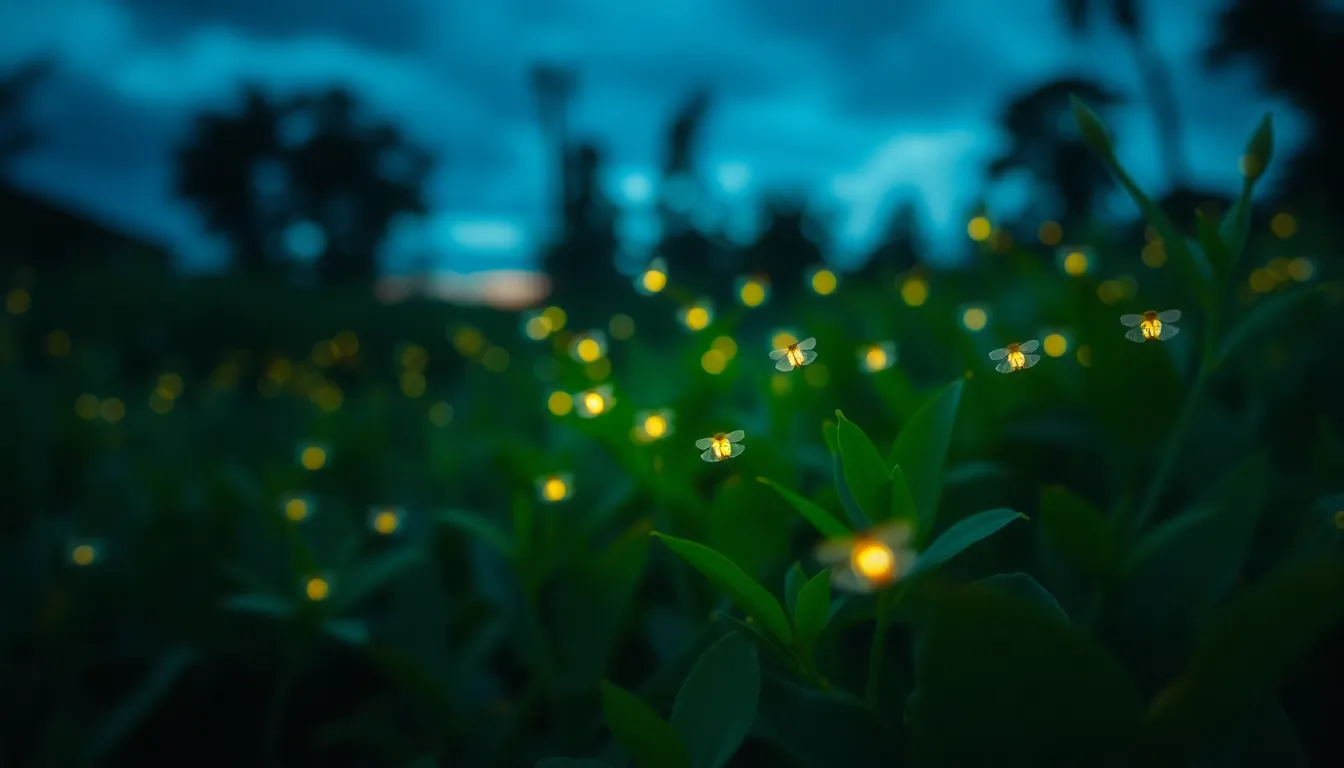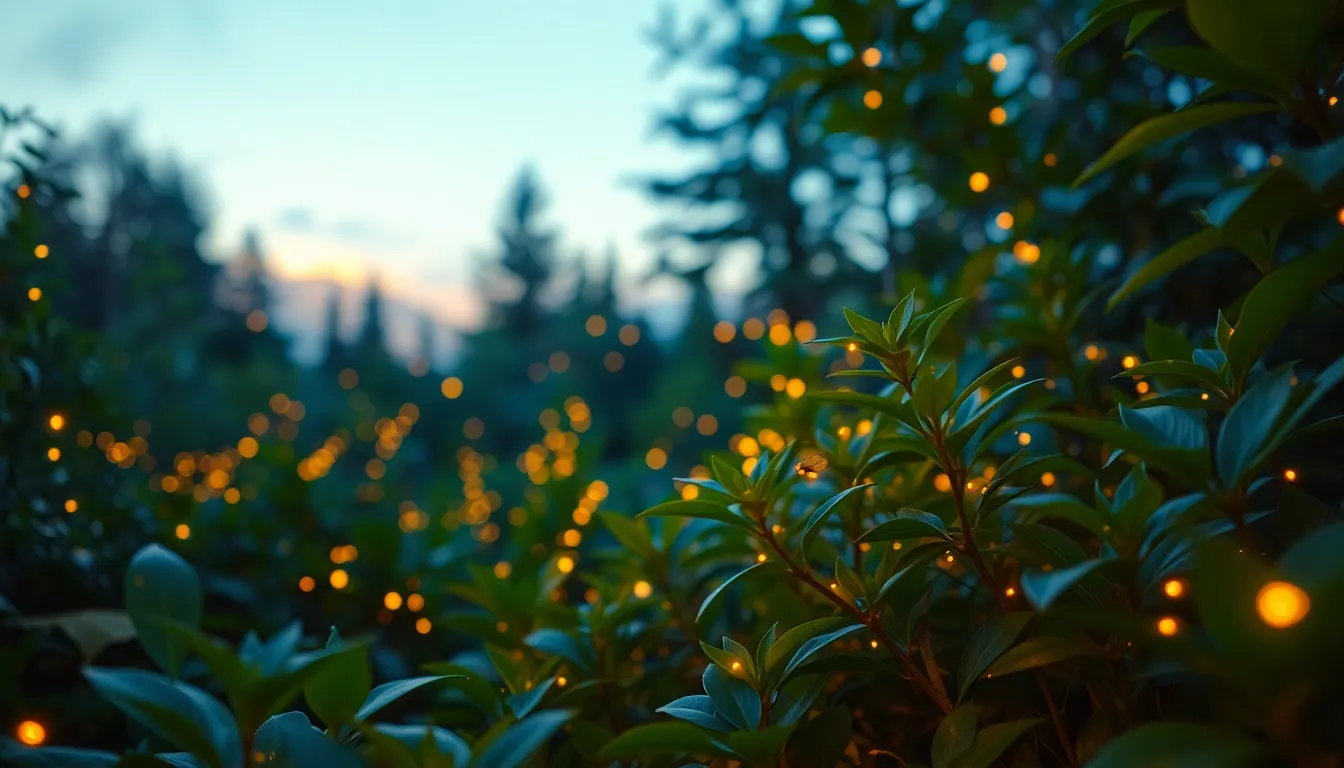Table of Contents
ToggleAs twilight descends and the air warms, a magical spectacle begins to unfold. Fireflies, with their enchanting glow, capture the hearts of many, signaling the arrival of summer nights. But when exactly do these luminous insects make their grand entrance? Understanding their emergence not only adds to the wonder of their presence but also highlights the delicate balance of nature.
Typically, fireflies appear in late spring to early summer, depending on the climate and geographical location. Their glow is more than just a beautiful sight; it plays a crucial role in mating rituals. As the days grow longer and the temperatures rise, these tiny creatures light up the night, reminding us of the beauty and mystery that nature holds.
Overview Of Fireflies
Fireflies, also known as lightning bugs, belong to the family Lampyridae and exist in various species. They typically emerge during late spring to early summer, with emergence varying based on geographic location and climate conditions. Regions with warm temperatures and high humidity often see fireflies arrive earlier, while cooler climates may delay their appearance.
Fireflies exhibit bioluminescence primarily for mating purposes. Male fireflies flash specific patterns of light to attract females. Each species has a unique flash pattern, which ensures mating occurs between the same species. This remarkable phenomenon not only assists in reproduction but also contributes to the enchanting ambiance of summer evenings.
Fireflies thrive in environments rich in moisture, such as wetlands, gardens, and forests. They often inhabit areas with tall grasses and vegetation, providing coverage and food sources. The presence of fireflies serves as an indicator of a healthy ecosystem, reflecting air and soil quality.
Understanding the behavior and ecology of fireflies reveals their crucial role in the natural world. They contribute to biological diversity and play a part in the food chain, serving as prey for various animals. Fireflies illustrate the interconnectedness of life within their habitats.
Life Cycle Of Fireflies

Fireflies undergo a fascinating life cycle comprising several stages: egg, larval, and adult. Each stage plays a crucial role in their development and survival.
Egg Stage
Fireflies lay their eggs in moist soil or on the surface of plants. These eggs are typically laid in clusters, with females producing around 20 to 100 eggs. The incubation period lasts approximately 2 to 4 weeks, depending on environmental conditions such as temperature and humidity.
Larval Stage
After hatching, firefly larvae emerge and begin their development. This stage lasts for several months, often up to a year. Larvae are carnivorous, feeding on small insects and snails. They possess bioluminescent abilities, using light to deter predators. During this stage, they undergo multiple molts, gradually growing larger until they reach maturity.
Adult Stage
The adult firefly stage marks the final phase of their life cycle. Emerging in late spring or early summer, adults typically live for 2 to 4 weeks. They primarily focus on mating, utilizing their distinctive light patterns for communication. After mating, females lay the next generation of eggs, continuing the cycle. Adult fireflies are essential pollinators and contribute to their ecosystems’ health.
Factors Influencing Firefly Emergence
Firefly emergence is contingent upon several environmental factors that affect their life cycle and behavior. Key influences include temperature, humidity, and light conditions.
Temperature
Temperature plays a crucial role in firefly emergence. Warmer temperatures, typically between 70°F and 85°F (21°C and 29°C), trigger adult fireflies to emerge from their larval stage. In regions where temperatures rise early in the season, fireflies may become visible by late spring. Conversely, colder climates postpone their appearance, sometimes until mid-summer, indicating how regional variations can affect their life cycles.
Humidity
Humidity significantly impacts firefly activity and emergence. Fireflies thrive in moist conditions, which facilitate mating and discourage predation. High humidity levels enhance the likelihood of fireflies appearing, as they prefer environments like wetlands and damp gardens. Typically, populations flourish in areas with relative humidity above 50%. When humidity drops, especially during prolonged dry spells, firefly sightings decrease, showcasing their dependence on moisture-rich habitats.
Light Conditions
Light conditions also influence firefly emergence. Dusk and evening hours, characterized by diminishing natural light, provide ideal settings for fireflies to exhibit their bioluminescent flashes. Street lights and other artificial illumination can disrupt their mating displays, leading to fewer sightings in urban areas. Firefly populations are more abundant in dark, secluded locations where natural light predominates, further emphasizing the importance of suitable light environments for their activities.
Regional Variations In Firefly Appearance
Fireflies exhibit distinct emergence patterns across various regions, influenced by local climates and environments. Understanding these regional variations provides insight into their life cycles and habitat preferences.
North America
In North America, fireflies typically appear from late spring to early summer, with variations based on geographic location. Southern regions, such as Florida and Texas, witness fireflies emerging as early as April, while northern areas like Canada may not see them until late June. Species like Photinus pyralis, commonly known as the common eastern firefly, thrive in humid areas and are more prevalent in the southeastern states. Temperature ranges of 70°F to 85°F support their activity, while wetland habitats foster their populations.
Europe
European fireflies generally emerge from late spring through the summer months. In countries like the UK and France, species such as Lampyris noctiluca appear around May. These fireflies favor moist environments like gardens and woodlands, where humidity levels are optimal for mating rituals. Cooler climates, particularly in northern Europe, may delay their appearance until late June or July. Factors like urban light pollution impact their visibility, making sightings more challenging in densely populated areas.
Asia
In Asia, firefly emergence varies significantly depending on the climate and region. In tropical areas like Thailand and Malaysia, fireflies appear year-round, with peak activity during the wet season between May and October. Species such as Pteroptyx tener emerge in large numbers along mangrove forests and riverbanks. In subtropical regions like Japan, fireflies appear in June, favoring warm, humid nights. The cultural significance of fireflies in Asian folklore underscores their enchanting presence during summer evenings.
Fireflies bring a unique charm to summer nights with their mesmerizing glow and vital role in ecosystems. Their emergence marks a seasonal shift that many eagerly anticipate. Understanding the factors that influence their arrival enhances appreciation for these fascinating creatures. As fireflies continue their delicate dance of light, they remind everyone of nature’s intricate connections and the importance of preserving their habitats. Observing their enchanting displays serves as a joyful reminder of the beauty that summer holds.




